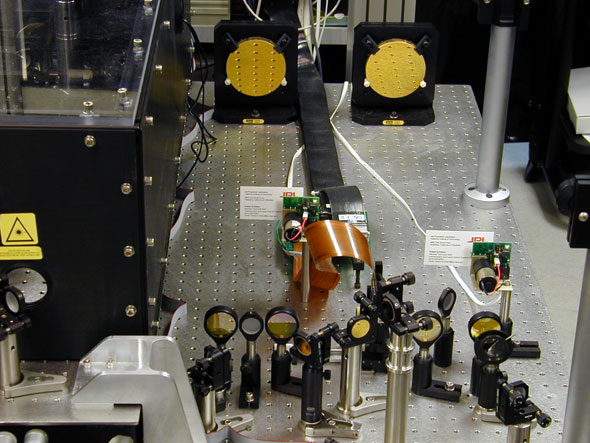News | December 3, 2008
Planet Hunters: Angling for extraterrestrials and Earthlike worlds

As an avid fly fisherman and geocaching enthusiast, Robert Peters is a natural hunter, which makes him the perfect person to work on technology to help find Earthlike planets. In his role as an engineer with JPL's Terrestrial Planet Finder project, he's responsible for the testing and development of the Adaptive Nuller - an instrument that will one day help scientists analyze the atmospheres of distant planets for signs of life.
PlanetQuest: What is an "adaptive nuller" and how does it help you find and characterize exoplanets?
Robert Peters: A nuller is basically an optical subtraction system that cancels out light coming from a star. One of the problems with nulling across a lot of frequencies of light is that the phase and amplitude of the light we need to cancel out is different at every frequency. An adaptive nuller automatically adjusts itself to cancel out light at each different frequency. Once you've gotten rid of the starlight you can analyze the light from the planet itself.
PQ: What's the difference between a nuller and a coronagraph?
 The Adaptive Nuller testbed.
The Adaptive Nuller testbed.
RP: A coronagraph is a lot like putting your thumb in front of the star to block out its light and see the planets that are orbiting it. A nuller actually combines waves of light so that they cancel each other out. The advantage of nulling is that you can use it with an interferometer, which allows you to combine the power smaller telescopes into one huge telescope.
Nulling is also more useful for observing planets in the mid-infrared band of light, whereas a coronagraph is better for visible light. A nuller is also useful for characterizing an Earthlike planet, because the dips in the spectrum that can indicate water or oxygen are more pronounced in the mid-infrared.
PQ: How does the nuller help scientists discover whether or not a planet can support life?
RP: The nuller can cancel out the light of a star at a ratio of 100,000 to 1 - then, we use other processes to go through the data that's left and find the light from the planets. Then, you can analyze that data to find markers of life in the atmosphere of the planet, like water and oxygen. The nuller is the first step in isolating enough of the planet's light to look for signs of life.
PQ: Does your job involve more software programming or testing out prototypes in the lab?
RP: It's a lot of both. The nuller is controlled by software that I have to program, but I have to set up the parts and test the system on a big breadboard that floats on air legs. Because the system is so sensitive to vibration, I have to test at night, after everyone's left the building - usually about once a week or so.
PQ: Is what you're working on now an actual instrument that will fly in an exoplanet-finding mission someday?
RP: The actual testbed won't be going to space, but we've demonstrated that the technology works and could be actually used successfully in the Terrestrial Planet Finder mission. In fact, when I first started this, it was a just a side project that I was asked to explore - now, it's a critical part of making the mission work.
 Not all of Peters' adventures are on foot.
Not all of Peters' adventures are on foot.
PQ: How did you end up working on such an interesting project?
RP: I was hired at JPL as I was finishing up grad school at Montana State University, studying physics and playing with lasers in the electric lab. When I eventually was transferred to the Terrestrial Planet Finder project, I worked with Oliver Lay, brainstorming on his idea for an adaptive nuller, so I started on the ground floor of this project. I didn't originally plan on getting involved with NASA, but I watched a lot of "Star Trek" when I was growing up and got a lot of variety while I was studying physics, so it makes sense that I ended up here.
PQ: When you aren't at work, what do you like to do with your spare time?
RP: Well, I like fly fishing - I have a fly rod under my desk that I take out to the creek near the lab sometimes when I want to relax. I've also gotten into tying my own flies and making my own rods out of bamboo. I like fly fishing because it's like hunting for fish - you have to convince them that this ball of thread you're tossing around is food. My wife Shannon and I also like to go geocaching.
PQ: Geocaching?
RP: It's a sport where people hide things in the woods - everything from toys to logbooks you sign when you find them. You're given GPS coordinates and clues and have to go find the prize. It's a lot of fun and a really good way to find new places to go hiking.
Written by Joshua Rodriguez/PlanetQuest




